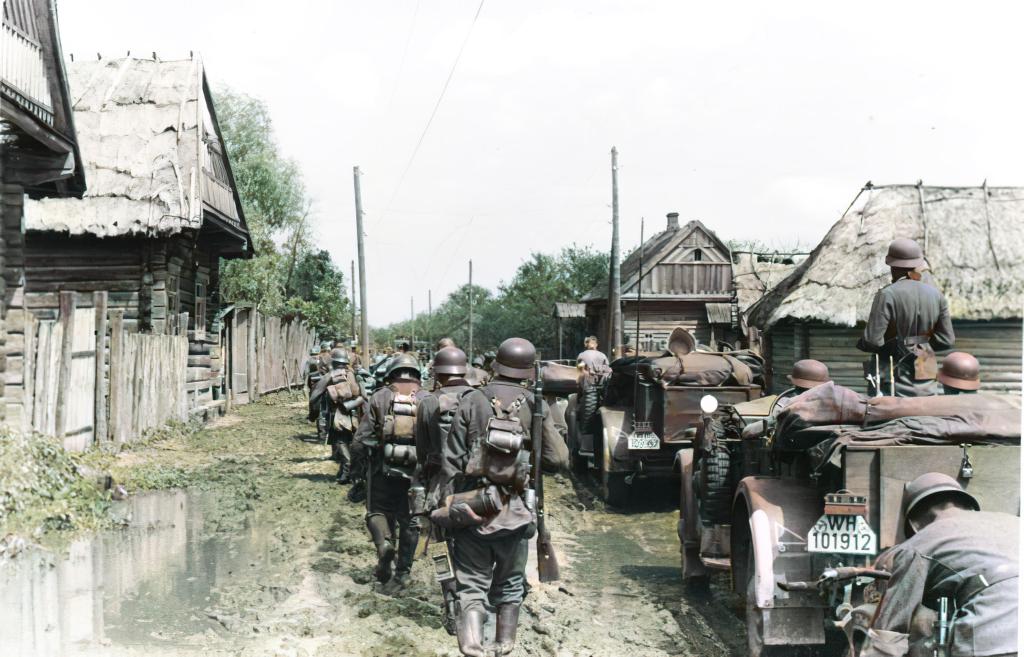Two days after the invasion of the Soviet Union began, Adolf Hitler moved his headquarters to the “Wolf’s Lair” in East Prussia, a complex of ugly, low-lying buildings deep in the mosquito-plagued forests. From this center, the Fuhrer would direct the war until it was seized by the Red Army in the closing months of the war.
But that time was far in the future. For the moment, it was hardly imaginable that the reeling Soviet forces could recover from the hammer blows with which they had been struck in the opening days. Although there were pockets of tough Soviet resistance, as at Brest-Litovsk, and Army Group North had encountered some heavy KV-1 tanks that were superior to anything the Wehrmacht possessed, for the most part everything was going according to plan. The Soviet air force had been all but destroyed, mostly on the ground, allowing completely unhindered reconnaissance and ground support from the Luftwaffe. One of the greatest difficulties the Germans faced was the vast amounts of territory being covered by their panzer and mechanized divisions, because the foot-slogging infantry divisions, whose supplies were pulled in horse-drawn wagons, were left far behind. Incessant marching in dust, heat, and occasional downpours of rain, strained the infantry to the exhaustion point. But the Red Army was too disorganized by the shattering blows they had received to cut off and annihilate the panzer spearheads, although they continued to inflict heavier casualties on the Germans than they had received during any of their encounters with the Western allies.
In the north, von Leeb’s army group made steady progress in its advance towards Leningrad, liberating the recently-occupied Baltic states of Lithuania, Estonia, and Latvia. In many of the cities, a population that had suffered greatly under Bolshevik tyranny helped the murderous SS Einsatzgruppen units in tracking down and murdering any Jews suspected of being engaged in sabotage or partisan activity. Army Group South, under Gerd von Rundstedt, faced the heaviest opposition, because it was there Stalin had deployed his best units, having laid plans for an offensive out of southwestern Ukraine. While they managed to push the Red Army back, there were no spectacular encirclements in the early days of the campaign. Meanwhile, the advancing Wehrmacht forces were greeted enthusiastically in many places by the Ukrainians, who had suffered perhaps more than any other Soviet republic, particularly during the mass starvation of the Holodomor. This hostility of the Ukrainians toward the Moscow-centered government, and their joyful reception of the Wehrmacht, goes a long way towards explaining much of the propaganda and genuine hatred that marks the current war between Russia and Ukraine.

It was Field Marshal Fedor von Bock’s Army Group Center which enjoyed the greatest success; and not surprisingly, since they had the most powerful panzer forces, Panzer Groups 2 and 3, led respectively by expert tanks commanders Heinz Guderian and Hermann von Hoth. In less than a week, these panzer groups had slashed an incredible 250 miles deep into Soviet territory, meeting up at the great Belorussian city of Minsk. The hard-marching German infantry closed another pocket at Bialystok.
These would be the first great cauldron battles of the war in the east. Some 300,000 Soviet soldiers would eventually surrender, but many fought with fanatical determination to break out, oftentimes in human wave assaults that were mowed down in windrows by German machine gun and artillery. Some 2,500 tanks were destroyed also in this battle, the first great success of the Wehrmacht, which promised to be the harbinger of many more if the Red Army did not learn quickly from the catastrophic errors it had made in the early days of the war.
